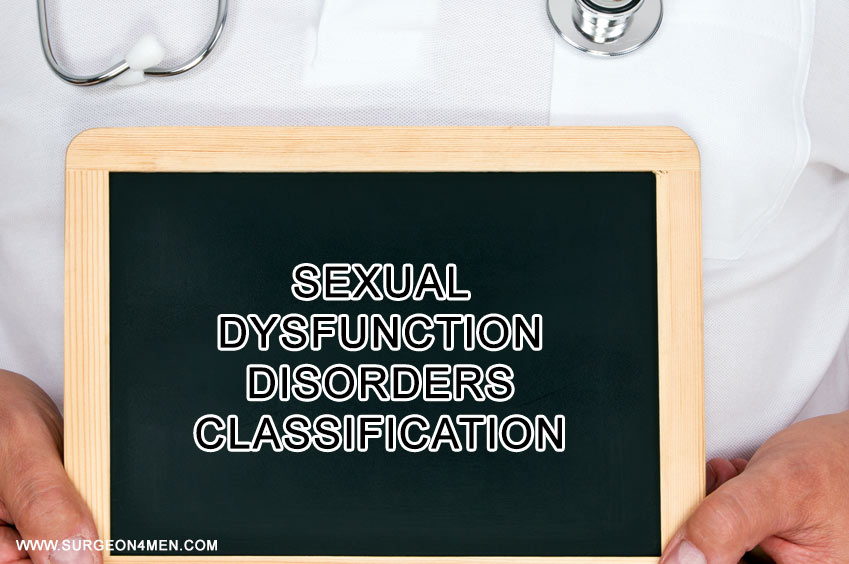Sexual Dysfunction Disorders Classification
Sexual dysfunction refers to a multitude of symptoms or ailments that may compromise the quality of sex life. In other words, any event that alters the intensity or duration of sexual response cycle and interferes with the sexual gratification/satisfaction can be classified under sexual dysfunction (SD).
Investigators and clinicians describe the primary phases of sexual response cycle as:
- Arousal/ Excitement: This includes sexual libido, interest in sex and capacity to get sexually stimulated when exposed to proper visual, tactile or mental stimuli.
- Plateau: Ability to maintain and sustain the sexual stimulation to achieve optimal gratification.
- Orgasm: The peak capacity to experience the sexual pleasure or gratification is referred to as the plateau.
- Resolution: The resolution of sexual excitement after orgasm marks the end of sexual response cycle.
It is imperative to mention that SD is fairly common in both males and females; but the prevalence is slightly higher in males under the age of 50 years. On the other hand, the prevalence increases abruptly in females after menopause. According to latest estimates, approximately 31% males and 43% females experience sexual dysfunction at some point of their life.
Sexual Dysfunction in Males vs. Females
 Most common clinical varieties of female sexual dysfunction are:
Most common clinical varieties of female sexual dysfunction are:
- Appearance of negative thoughts during sex
- Loss of interest in sex (overall low libido)
- Vaginal dryness
- Vaginal tightness during sex (or dyspareunia)
Most common clinical varieties of male sexual dysfunction include:
- Erectile dysfunction (ED)
- Painful erections
- Ejaculation issues.
Classification of Sexual Dysfunction Disorders
The 4 primary sexual dysfunction disorders are:
1. Orgasm Disorders
The affected individual fails to achieve orgasm; in other words climax is not achieved or is significantly delayed. Many physical factors are implicated in the pathogenesis of orgasmic disorders; such as:
- Chronic metabolic disorders (such as long standing diabetes, obesity, chronic illness, disability etc.)
- Certain medications also affects the capacity of an individual to achieve orgasm.
- Psychological factors; such as strong cultural or religious stance on sex, feeling of guilt while engaging in sexual intercourse, intense performance anxiety and relationship issues.
- Research reported in the peer reviewed journal The Journal of Sexual Medicine (2), suggested that sexual dysfunction and orgasmic disorder is more common in menopausal females with metabolic syndrome.
2. Sexual Arousal Disorders
These individuals experience poor arousal or loss of interest in sexual activities. Severe cases of sexual arousal disorder may lead to impotency in males and constrained relationships in females. Poorly managed sexual arousal disorders are almost always associated with decline in sexual excitement, pleasure and orgasms.
Some common factors that may lead to sexual arousal disorder are:
- Partial erection in males or vaginal dryness in females (due to menopause)
- Low serum levels of primary reproductive hormones (such as testosterone in males or estrogen in females).
3. Pain Disorders
 Painful intercourse (also referred to as dyspareunia in sophisticated medical terms) is a fairly common cause of poor libido in both males and females. Some common causes of pain disorders are in females are:
Painful intercourse (also referred to as dyspareunia in sophisticated medical terms) is a fairly common cause of poor libido in both males and females. Some common causes of pain disorders are in females are:
- Inadequate lubrication of vagina can present with moderate to severe pain during intercourse that may makes it difficult to allow optimal penile penetration. Poor lubrication can be hormonal i.e. changes in the serum level of hormones that interfere with the excitement phase of the sexual response cycle during sex. The hormonal changes may be because of menopause, pregnancy, breast feeding (lactation) etc.
- Non-hormonal causes of poor vaginal lubrication include side-effects of certain medications (anti-hypertensive medications, contraceptive pills, acetylcholine blockers etc.).
- Vaginismus, is a painful spasmodic condition of vagina that is marked by sudden onset of involuntary contractions of vaginal muscles. This sudden spasm causes pain during sex and may also make it difficult to maintain normal day to day operations such as long hours of sitting or walking etc. Little is known about the pathophysiological factors that may lead to Vaginismus, but scientists believe a positive history of sexual assault or pelvic trauma can aggravate the risk several folds.
Common causes of pain disorder in males are:
- Priapism: It is a condition that is marked by painful and prolong penile erections in the absence of any sexual stimulation. In some cases priapism may persist for hours and may require emergent medical management to minimize the risk of permanent damage to genital apparatus. Priapism is the result of accumulation and trapping of blood in the penile tissue due to vascular or neurological defects. Priapism is very frequently associated with certain medications.
- According to another study (3), male cancer survivors (colon or rectal cancer) survivors often experience erectile dysfunction or sexual disorders due to moderate pain and pelvis discomfort.
4. Desire Disorders
This disorder includes a loss on interest in initiating an intercourse. This condition is often referred to as low libido and is usually transient. A decline in male and female sexual hormones can affect sexual desires. Other vital factors include:
- Moderate depression and stress
- Physiological aging
- Use of certain medications (selective serotonin reuptake inhibitors)
- Pregnancy or lactation
- Chronic illness
- A change in the environment, job or other living conditions
If you are experiencing sexual dysfunction, it is very important to discuss your case with a registered healthcare professional to learn more about the causes, risk factors and appropriate therapeutic options.
References:
- Christensen, B. S., Grønbæk, M., Osler, M., Pedersen, B. V., Graugaard, C., & Frisch, M. (2011). Sexual dysfunctions and difficulties in Denmark: Prevalence and associated sociodemographic factors. Archives of sexual behavior, 40(1), 121-132.
- Martelli, V., Valisella, S., Moscatiello, S., Matteucci, C., Lantadilla, C., Costantino, A., … & Meriggiola, M. C. (2012). Prevalence of sexual dysfunction among postmenopausal women with and without metabolic syndrome. The journal of sexual medicine, 9(2), 434-441.
- Den Oudsten, B. L., Traa, M. J., Thong, M. S. Y., Martijn, H., De Hingh, I. H. J. T., Bosscha, K., & van de Poll-Franse, L. V. (2012). Higher prevalence of sexual dysfunction in colon and rectal cancer survivors compared with the normative population: a population-based study. European Journal of Cancer, 48(17), 3161-3170.
- Manolis, A., & Doumas, M. (2012). Antihypertensive treatment and sexual dysfunction. Current hypertension reports, 14(4), 285-292.
- Baldwin, D. S., & Foong, T. (2013). Antidepressant drugs and sexual dysfunction. The British Journal of Psychiatry, 202(6), 396-397.

